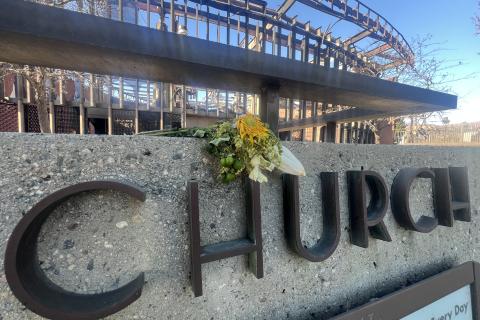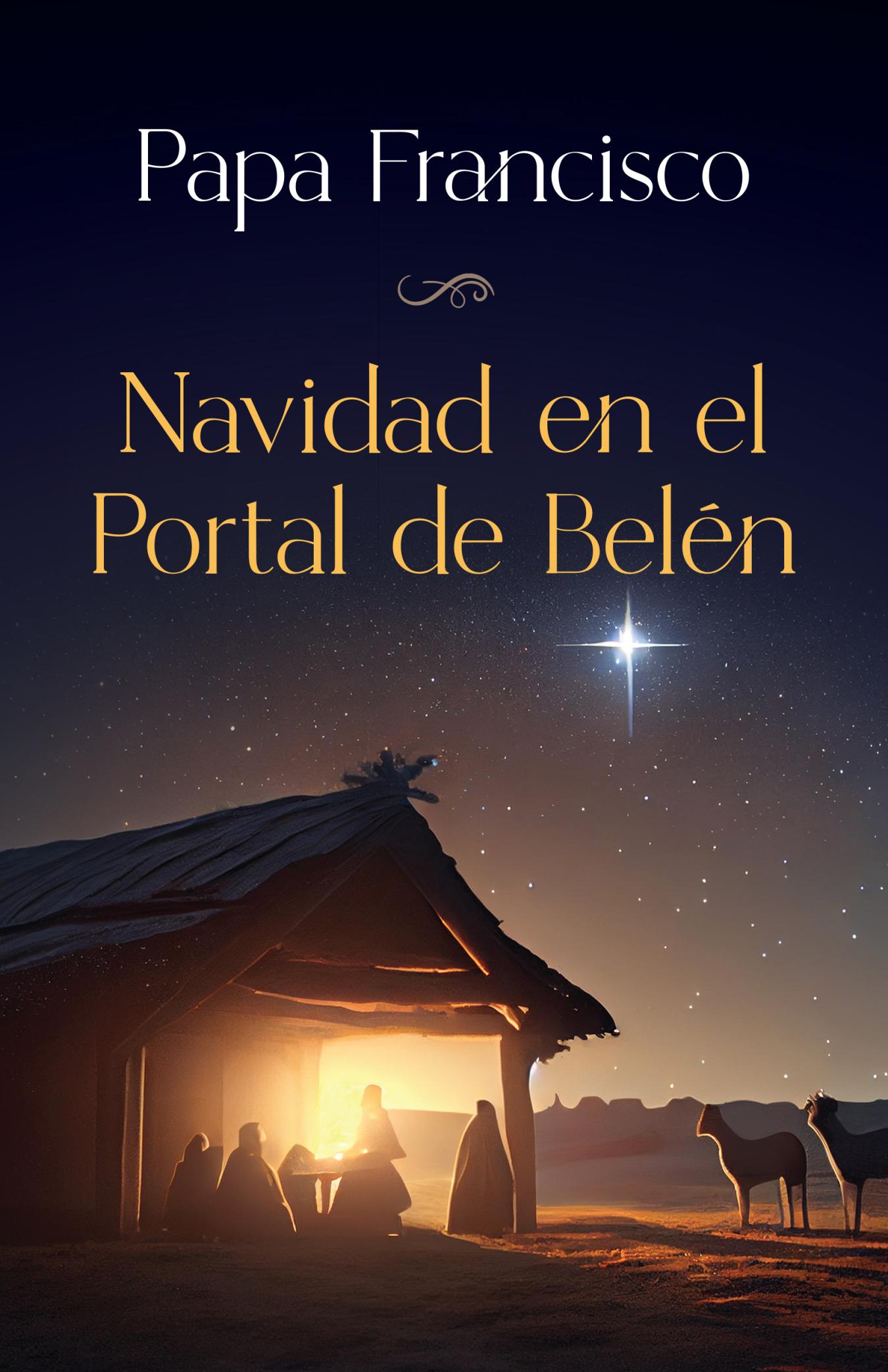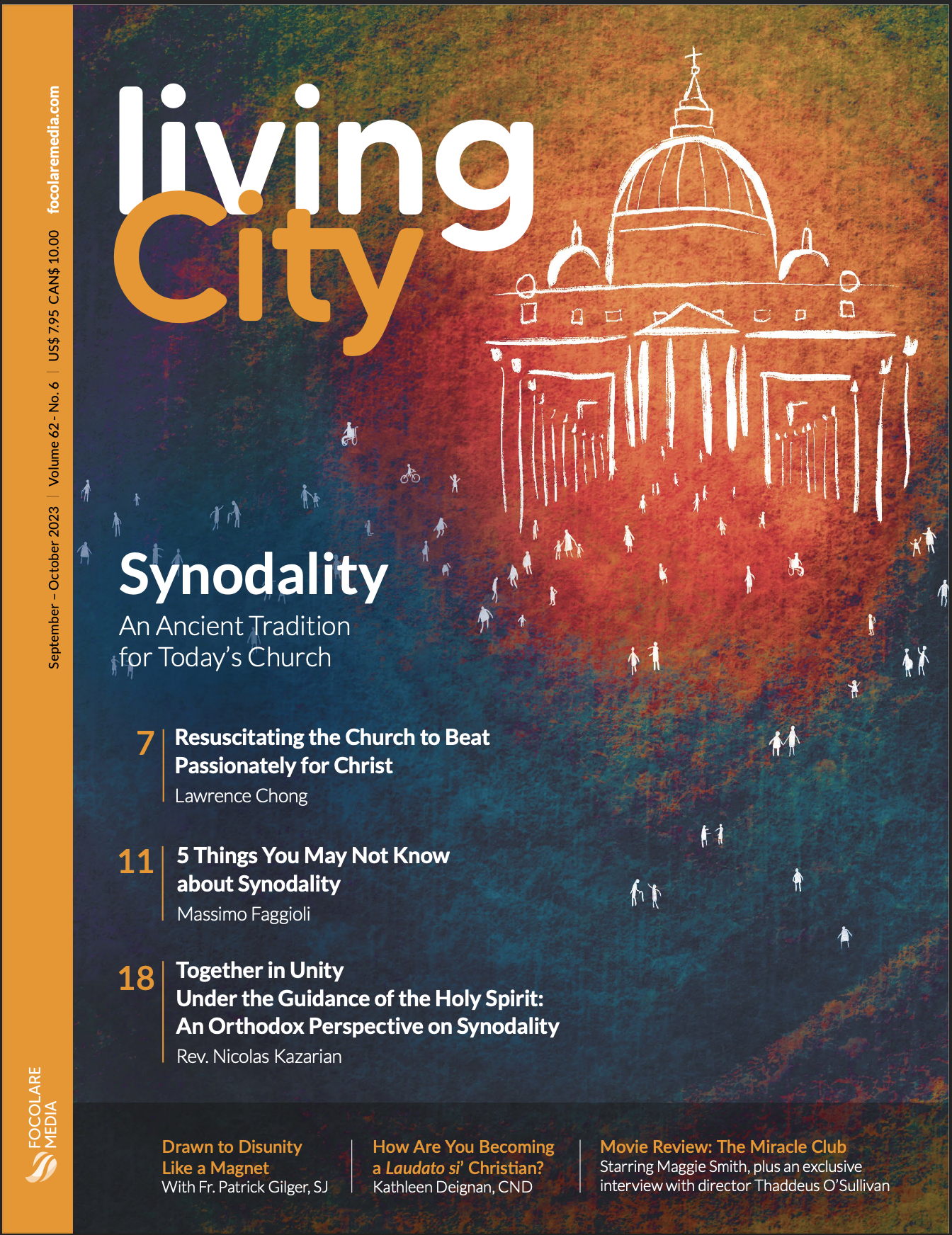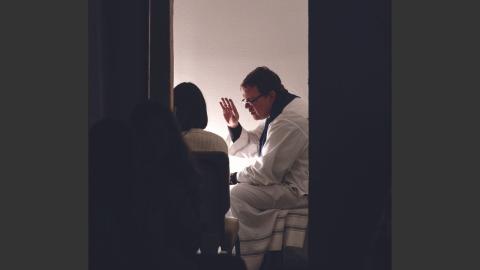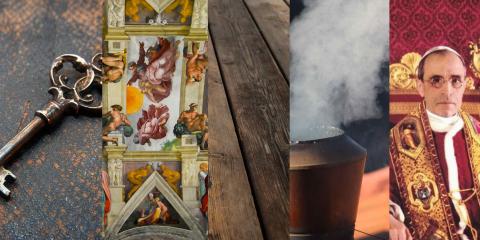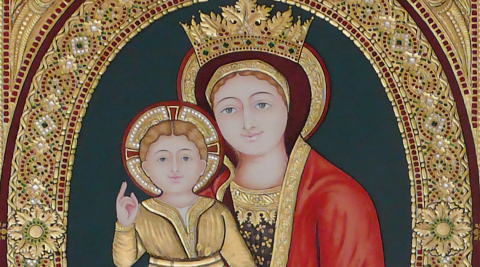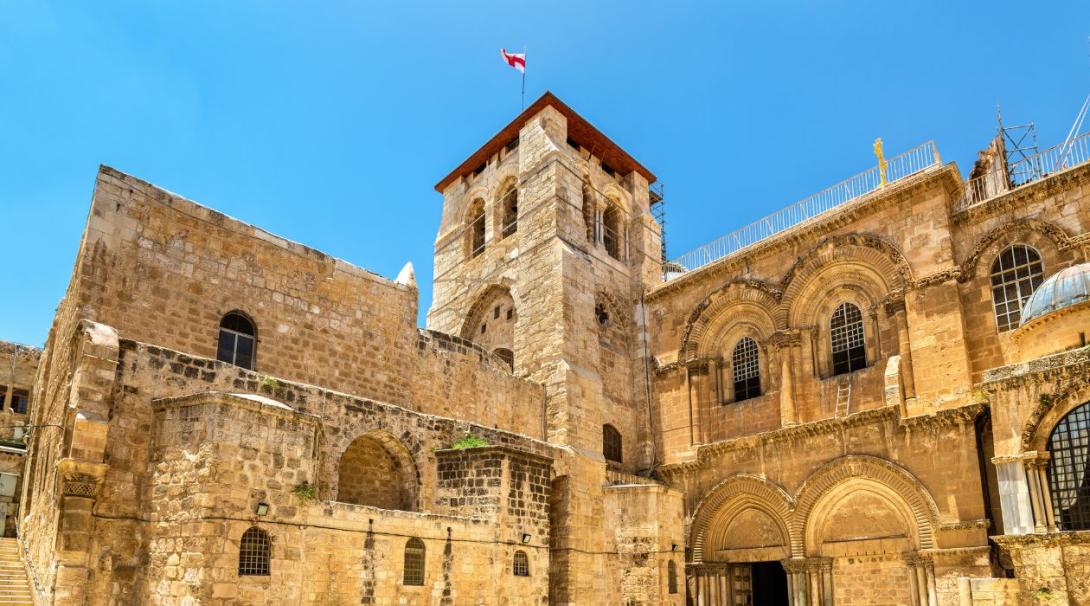
The Church of the Saint Sepulchre, photo by Leonid Andronov
“Not without a providential design, the historical events of the thirteenth century brought the Order of Friars Minor to the Holy Land. The sons of St. Francis have, ever since, remained in the land of Jesus—for an uninterrupted series of years—to serve the local Church and to guard, restore and protect the Christian Holy Places.” This is from Pope Paul VI’s 1974 apostolic letter Nobis in Animo, recalling the origin of the Custody of the Holy Land.
Franciscans are linked to the Christian East with very special and centuries-old ties. St. Francis in 1219 amidst the Fifth Crusade went to Egypt and the Holy Land, leaving his sons with a sense of special predilection for the places where Christ spent his earthly life.
Already in the General Chapter of the Order, celebrated at the Portiuncula near Assisi in 1217, the Province of the Holy Land was established, which at first included all the countries of the eastern Mediterranean basin, from Greece to Egypt.
The Crusades’ religious aspiration was revived by St. Francis, who attempted to proclaim the Gospel to the Muslims; for him, it was not a question of an armed crusade, but one of faith and evangelical preaching. The fruitfulness of this new ideal would show itself clearly throughout the centuries, despite the adventurous events that characterized the history of the Mediterranean near-east.
St. Francis was the first founder of a religious order that composed a chapter in their Rule devoted to missions without distinction of ethnicity.
Bethlehem and Calvary, that is, Greccio and La Verna, find echoes in the life of St. Francis, and later in the Custody of the Holy Land. St. Francis was the first founder of a religious order that composed a chapter in their Rule devoted to missions without distinction of ethnicity. The idealistic Francis initiated a new kind of crusade, and if the leaders of the time had understood the new scope of his message, they might even have discerned its fruits. The idea of an armed crusade was increasingly weakening.
In 1291, the crusaders lost the city of Acre and later all other coastal cities, which were conquered by Sultan Qalaun’s son, Al-Asharaf Khalil. The Franciscans who had been present in the Holy Land took refuge in Cyprus, which became the main seat of the province, but in time they again became increasingly active in Jerusalem and other holy places. On August 9, 1328, with the bull Cum zelo devotionis, Pope John XXII granted the minister provincial of the Holy Land residing in Cyprus the possibility to send two religious to the holy places each year.
In the following century an initiative undertaken by the Kingdom of Naples led to the establishment of the Custody of the Holy Land and the uninterrupted stable presence of the Friars Minor there to this day. The royals of Naples did not ask the sultan for the territories, but only for the peaceful restitution of the holy places and freedom of worship in them. Then, it was a Franciscan friar from the Province of Aquitaine—Geraldo Oddone (Eudes)—who, with the mandate of the general of the Franciscan Order, succeeded in acquiring from the sultan of Egypt the cenacle on Mount Zion and founded a convent.
In 1342, Pope Clement VI, with two bulls, Gratias Agimus and Nuper Carissimae, officially charged Franciscans with guarding the holy places on behalf of the Catholic Church. The Pope also instructed the minister general of the Order to provide for the presence of twelve friars in Jerusalem.
The first two Franciscan residences, the Upper Room and the Sepulcher, were joined in 1347 by the one in Bethlehem at the Basilica of the Nativity of Our Lord Jesus Christ. At an unspecified date but within the following four decades, the convent of St. Savior in Beirut, Lebanon was also placed under the direct jurisdiction of the father guardian of Holy Mount Zion.
In 1421, Pope Martin V, in a ruling made after a dispute concerning the possession of the four shrines guarded by the Franciscan friars, wishing to recover the old orders and the diocesan clergy who took care of them at the time of the Crusades, confirmed the friars’ possession of them.
What is most striking is their patience in trying to remain faithful to Christ’s mandate, that is, to bear witness to him, despite everything, in a traditionally hostile environment. That the holy places still exist and are, for the most part, under the protection of Franciscans is the most precious pearl of the Franciscan Order.
The nefarious Turkish rule in the Holy Land, which lasted four centuries, began in 1517. In 1551, the Turks drove the friars out of the Holy Cenacle and the adjoining convent. In 1570, with the occupation of Cyprus, the friary that the Custody owned there as the closest point of support in Christian lands, was lost. In 1571, the convent in Beirut was also lost. The friars were ousted from the cenacle after a decade of travails and attempts—but they managed to acquire another friary in Jerusalem, St. Savior’s, which from 1560 became the Custody’s new headquarters. From here, new initiatives began that went beyond the traditional boundaries of the Holy Land proper. The Franciscan apostolate extended to Aleppo, Tripoli, Cyprus, and Alexandria in Egypt: at first as religious assistance to merchants and those who passed through these cities, then developing more and more, making the presence of the friars in these countries stable.
A new phase in the history of the Custody of the Holy Land opened in the seventeenth century, lasting through the rest of Turkish rule. And more fixed residences were added: Nazareth (1620), St. John in Ain Karem (attempted in 1621, definitively in 1674), and Acre (1629). The Ramle House, previously owned by the friars for the use of transit pilgrims, in 1658 began to be a fixed residence of religious communities as well.
Equally untiring care was shown in the purchase of three other holy places, which, only with the end of Turkish rule were appreciated in their value and significance: Mount Tabor (purchased before 1631), the Garden of Olives at Gethsemane (1661 and 1681, dates of significant purchases concerning the holy area), and the Visitation in Ain Karem (1679). In addition, a house was obtained in Jaffa, a port directly connected with Jerusalem, in 1654 as a support point for arriving or departing religious and pilgrims.
The eighteenth century saw the construction of the Church of the Annunciation in Nazareth (1730), the purchase of the most remarkable part of the ruins of the ancient church/sanctuary of St. Joseph (1754), and the permanent settlement of the friars in Jaffa. Then came a renewed flowering of Franciscan presence. Some fifteen other holy places were recovered throughout the nineteenth century, secured to Catholicity, among them Bethany, Bethphage, Emmaus, Cana of Galilee, Tabga (place of primacy), and Capernaum. In 1847, when the Latin Patriarchate was reconstituted, the friars became the sole representatives of Catholic clergy to take care of the souls of local Christians and pilgrims.
Pope Urban VIII had reiterated much earlier, in clear terms, that it was a duty of all Catholic princes and supreme pontiffs to protect the Franciscans of the Holy Land, because the holy places were in their custody in the interest of all the faithful. And on February 8, 1852, the friars appealed directly to the Holy See to restate the same again to those Catholic powers.
So the history of Franciscans in the Holy Land has been colorful, holy, and vital for the Church and the world. We could also look at it—chronologically—as follows.
The first period took place during the Crusades (1217–91), when the work of the Franciscans was carried out in spiritual assistance to pilgrims and Western merchants, and to the Christian inhabitants of the new Crusader kingdom, where, moreover, the apparatus of an ecclesiastical hierarchy was already present and functioning.
The Franciscans of the Custody of the Holy Land have constituted a constant and uninterrupted presence in a land that has experienced significant ethnic mutations…
A second period, marked by Arab Muslim control and settlement of the region, saw the situation radically transformed. The official and exclusive religion in the East became Islam beginning in 1329, until about 1517. During this time, Franciscans returned to the Holy Land, virtually as the only representatives of all Christendom, and cared for the remaining Christians there, including non-Catholic minorities. This was yet another form of apostolate that developed concerning the spiritual care of European traders residing or passing through the first-order marketplaces of Egypt, Syria, and Lebanon—especially during Advent or Lent. Franciscans first entered as chaplains of European consuls and European trading colonies and remained there as apostles serving all, thus creating preambles of real parishes with attached works of care for souls and bodies.
The situation evolved further in what we might call a third period, with the change of Muslim rule from Arab to Turkish. This began in 1516 and lasted until 1917. The importance of the Franciscans was accentuated as the Holy See appointed the Father Custodian as ecclesiastical superior and apostolic delegate-commissary with ordinary jurisdiction over the Middle East. Ottoman authorities, while establishing discrimination among Christians in favor of the Greek Orthodox (Greece was part of the empire), allowed the Custody to form Catholic parishes even though the Catholic faithful, to continue professing the faith and worshiping, had to undergo severe fiscal harassment. It is in these difficult centuries when friars multiplied initiatives such as the establishment of schools at convents, usually also parish headquarters, making Eastern Catholic Christendom flourish again. They also provided assistance to the poor and sick by assuring them homes, doctors, and medicine. They were genuine pioneers in these works.
A fourth and final period opens with the fall of the Ottoman Empire until the present day, and sees the Custody maintaining the care of many parishes, even after the custodian father no longer has hierarchical roles within the Church. Alongside this pastoral activity with twenty-three parish churches, the friars carry out other tasks in the fields of education (in 2023 there were sixteen schools of the Custody of the Holy Land with 9,468 students), culture (the Studium Biblicum Franciscanum, the Center for Oriental Studies in Cairo-Musky, Franciscan excavations and archaeology, the Franciscan printing press with scientific publications and reviews), charitable (the orphanages, hospitals, homes for the elderly), apartments for the Christians (350), service at shrines and to pilgrims, liturgical service at shrines, and hospitality service offered to pilgrims.
The Franciscans of the Custody of the Holy Land have constituted a constant and uninterrupted presence in a land that has experienced in the same period significant ethnic mutations (Latins, Arabs, Turks, Jews); radical political upheavals (crusader kingdom, Arab rule, Turkish rule, British mandate, new state of Israel, Palestinian Autonomy); a rapid succession of protagonists (al-Mālik al-Kāmil, St. Francis, Saladin, Frederick II, Suleiman the Magnificent, Napoleon, General Allenby, Ben Gourion, Arafat); and an uninterrupted fluctuation of borders.
It all goes back to the beginning of the thirteenth century, when the Crusades were showing signs of the inherent crisis that would bring about their unsuccessful end, and a new organization, a group of men from the religious order founded by St. Francis of Assisi, devoted themselves to the lifelong aspiration of all Christendom: access to and the possibility of praying before the holy places linked to the life of Jesus the Redeemer, a possibility which is maintained by the friars of the Custody of the Holy Land to this day!






